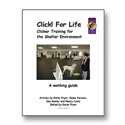An overview
Humane societies and rescue organizations across the country are beginning to incorporate positive reinforcement with a marker signal, or "clicker training" techniques, as part of their routine animal management and care.
Why clicker training and not just positive attention and food rewards?
Clicker training is fun and easy to learn, for animals and people both. The clicker is a consistent signal, giving the animal confidence, no matter who is clicking. From a click and treat here and there shelter dogs can learn desirable behavior such as sitting instead of jumping up at the kennel door, or being quiet instead of barking. Dogs that have learned how to "make people click" tend to become calmer and more confident, and thus more adoptable. Even two or three extra minutes spent clicking and treating an individual animal can be time well spent.
This is important in the shelter environment, because there is seldom any time to train in the traditional manner through commands, corrections, and repetition. Clicker work can be woven into the daily shelter activities such as feeding animals and cleaning cages. Clicker training can quickly improve the way animals respond to people. It's rewarding for the animals, and for staff and volunteers, too.
But how do you begin, if this is all new territory to staff and volunteers? Here are a series of levels of involvement:
- Level I: Educate yourself and allow others to be educated. Our Shelter Orientation Pack provides the basics for self-teaching clicker training. Free documents on effective exercises such as Making your Kennel a No Bark Zone and core information like the One Page Summary of Clicker Training are available directly from our website. Adopting families need education, too. Shelters report that families who start or continue clicker training at home are more likely to retain the dog. A Level I shelter can make self-teaching kits Getting Started: Clicker Training Kits (Dogs and Cats) part of the adoption package or available for adopters to purchase, so they can continue the clicker experience with their new pet at home. Shelters learn from other shelters. On our Clicker Training Shelter Resource page you can share stories, insights and experiences, as well as learn from others. An organization with an on-going program in place is always a valuable source of guidance for shelters in earlier stages of development
Level II: Incorporate clicker training into your husbandry and animal care practices. Clicking for handling and socialization can be part of every animal's experience, with benefits not only to the animals but to the staff. Success with the animals is reinforcing and more interesting than just feeding and cleaning. Clicked animals are less stressed and easier to manage. At Level II clicker training becomes fully integrated into all husbandry and animal care; if training is provided, it is positively based clicker training rather than conventional correction-based training. When these behavioral practices become the norm, shelters report that not only do adoption rates go up, but staff burnout and staff conflicts are reduced.
Level III: Expand your clicker training program outside the organization. This might include clicker classes for adopters and for pet owners in general, informational programs for donors, board members, and others involved with the shelter, and outreach programs to the community at large. It may also include developing training programs for interested staff and volunteers in teaching clicker classes.
Level IV: Incorporate the principles of shaping and positive reinforcement into the management of the shelter itself. Good management is much more than budget control and hiring the right people. The level IV shelter uses positive reinforcement and provides learning opportunities throughout the organization. Shelters at this level, whether large or small, may attract better-educated and motivated volunteers and employees, and may see significant improvements in their funding and in community recognition and involvement.
For assistance designing a clicker program for your shelter, contact a Karen Pryor Academy Certified Training Partner.








amazing idea
I think it would be a great idea to try it at a boarding kennel. I think you'd see the same success there as many shelters are seeing when implementing the program. Do let us know how it goes!
--
Laurie Luck
For Clickertraining.com
Karen Pryor Academy Certified Training Partner
See my profile and contact information at
http://karenpryoracademy.com/Luck_Laurie
Amazing idea
I am in love with this idea. In all my work with kennel/shelter dogs I have never considered introducing clicker training to keep the peace. Do you think it is feasible to try it in a boarding kennel? I would love the kennel I work at to be a quieter, more polite environment for everyone involved. Less noise would filter through to the clients and the dogs' stress levels would decrease drastically (not to mention those of the employees).
No Bark Zone progress
I have done this for 2 sessions and the dogs are not barking. I have 3 that are still jumping, but not when I'm near with the clicker/treats. There are also two dogs who are restless, but no barking for feeding time, or going outside to their exercise areas. This is so simple and something I never thought of. Thank you!
Post new comment